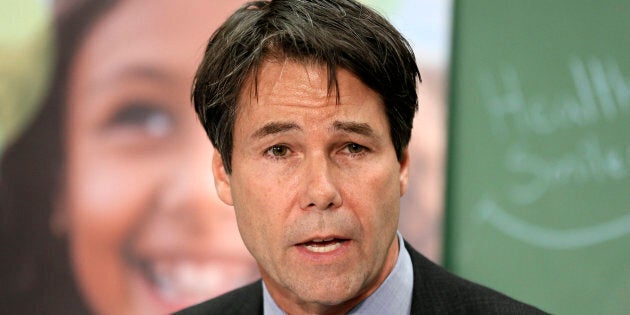
We've come to the end of another Mental Illness Awareness Week, the time of year when government suddenly finds the money and resources for programs and initiatives long overdue which they announce with great fanfare and pretty press releases that in the end, leave us all shaking our heads as to what exactly has been promised.
It's a song and dance I know well, having worked on both sides of the fence in government communications and news reporting.
If the media is doing its job right, reporters will ask questions and clarify statements so that people can understand exactly how they will be affected.
Unfortunately, I didn't see much of that happen this week.
So while I hate to get political, as a mental health journalist and someone who cares for a child with mental health conditions as well as battling anxiety and depression myself, I feel it's important to dig a little deeper into Monday's announcement by the Ontario Ministry of Health and Long Term Care (MHLTC) to clarify just what exactly they meant when they said they would be "expanding psychotherapy programs across the province" for people with anxiety and depression.
The press release mentioned three different ways in which, for the first time ever, covered under OHIP, people in Ontario would be able to access structured psychotherapy in the coming three years:
- Through in-person and group therapy at community mental health agencies;
- Self-administered through a program called Bounce Back that includes telephone support and instructional workbooks; and
- Through online self-management tools via the Ontario Telemedicine Network.
The evidence is strong that a combination of psychotherapy and medication is the best form of treatment for anxiety and depression. But there are wait lists to see a psychiatrist and those with health insurance through their job with coverage for psychotherapy can see a psychotherapist but the coverage usually only extends to just a few sessions. Those who can afford to pay for private psychotherapy, however, are able to avoid the queue and get help right away.
We live in a two-tier system where those who can afford to get psychotherapy receive treatment right away while those who can't languish on wait lists as their conditions worsen. According to Monday's announcement, Ontario will become the first province to provide publicly-funded structured psychotherapy.
We live in a two-tier system where those who can afford to get psychotherapy receive treatment right away while those who can't languish on wait lists as their conditions worsen.
Does this mean Ontario will be covering the services of psychotherapists under OHIP?
Following the smiles-and-shovels ground-breaking announcement at the Centre for Addiction and Mental Health (CAMH) where Minister of Health and Long Term Care, Dr. Eric Hoskins was also celebrating the future addition of 235 new inpatient beds, I emailed David Jensen from the Communications and Marketing Division at MOHLTC for additional clarification.
"The Increasing Access to Psychological Therapies (IAPT) Demonstration Project is led by the four psychiatric hospitals — CAMH, Ontario Shores Centre for Mental Health Sciences, Royal Ottawa Health Care Group and Waypont Centre for Mental Health Care," says Jensen. "Through this project, the four hospitals are developing a standardized psychotherapy model to deliver in community-based settings, including family health teams, community health centres, and community mental health and addictions agencies."
Jensen goes on to explain that in order to ensure that the province is rolling out group and individual psychotherapy that adheres to a standardized, evidence-based treatment model, they will rely on the clinical expertise housed in the four hospitals to oversee training and supervision.

"Service provision will actually occur in the community — in community mental health agencies, in connection with the primary care provider, and through other organizations such as family service organizations that partner with these four hospitals," says Jensen.
"The IAPT Demonstration Project led by the four psychiatric mental health hospitals is the modality offered through the announced funding that offers in-person psychotherapy. Qualified, trained health-care providers will provide in-person therapy, such as social workers, psychologists, psychotherapists, registered nurses, and occupational therapists."
While working to expand existing evidence-based services such in-person psychotherapy at community mental health agencies over the next three years, Jensen says the ministry will also be working on a provincially structured psychotherapy program to standardize the level of care patients will receive across the province.
Jensen explains Ontario's funding of psychotherapy services is part of the province's $140 million investment in mental health support over three years. The province is investing $72.6M over three years to support different types of psychotherapy services, which will provide more ways for Ontarians to address their specific challenges and improve their mental health. The investment will support additional requirements to expand the programs which cannot be leveraged through pre-existing human and capital resources.
More blogs to read:
"It means the answer to your question is no," says Ontario registered psychotherapist Christina Crowe. "Varying the delivery medium is fantastic. But who are the practitioners?... All I know is that there are over 4000 registered psychotherapists in Ontario and we're all private, our services depend on patients' private insurance, whose coverage is dictated by employers. There is no shortage of qualified practitioners, from psychologists to psychotherapists who practice evidenced-based psychotherapy for anxiety and depression. But there is no virtually public support for Ontarians who need treatment, which is a daily frustration."
Crowe is concerned that the announcement doesn't properly address the significant gaps that currently exist, most notably the lack of practitioners with appropriate training for OHIP-funded psychotherapy. She says the wait lists are over a year long for many of these limited practitioners and that most community-based mental health organizations are time limited, offering a maximum of one to three sessions with a different therapist every time.
"This could be great," says Crowe. "It's still unclear that a patient could choose their own psychotherapist."
Another burning question I had for Jensen was whether the new expanded psychotherapy programs would also be helping children and youth with mental health issues.
It is surprising that the Ontario government is not putting more funds behind treatment and supporting children and youth because we have clearly asked repeatedly for funding...Kimberley Moran
Jensen replied that the programs identified in the announcement target adults aged 16 and over but that the provincial structured psychotherapy program yet to be developed would be accessible to Ontarians across the lifespan, including families, children and youth.
But Kimberley Moran, CEO of Children's Mental Health Ontario (CMHO) disagrees.
"As children and youth mental health services fall under the jurisdiction of the Ministry of Children and Youth Services, community-based children and youth mental health agencies do not receive funding or program direction through MOHLTC so at this time would not have access to this program," says Moran.
"It is surprising that the Ontario government is not putting more funds behind treatment and supporting children and youth because we have clearly asked repeatedly for funding for more psychotherapy and they are well aware that 70 per cent of mental illness has its first onset during adolescence and that those receiving the right kind of treatment at the right time can improve their long-term mental health."
Moran says there has been no increase in resources towards community-based children's mental health in over a decade.

"CMHO has called on government to rectify the $120-million funding shortfall so community-based child and youth mental health centres can hire additional psychologists, social workers, nurses, child and youth workers and other mental health professionals to serve the almost 12,000 children currently waiting up to 18 months for treatment."
Despite the skepticism, I'm hopeful the province will come through on its plans to deliver structured psychotherapy and that its plan will reduce and eventually eliminate wait times for people desperately waiting for treatment for anxiety and depression.
"It's a decent start," says Crowe.
I agree. I just hope we get started sooner rather than later and next year is an election year, which could slow down, change, or worse, cancel plans altogether depending on whether the Liberals get re-elected or not. Here's hoping whatever the outcome, all political parties continue to see the value and urgency in providing psychotherapy treatment for children, youth and adults with mental health conditions.
Our lives depend on it.
Also on HuffPost: